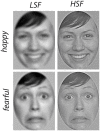Exploring the Role of Spatial Frequency Information during Neural Emotion Processing in Human Infants
- PMID: 29062275
- PMCID: PMC5640713
- DOI: 10.3389/fnhum.2017.00486
Exploring the Role of Spatial Frequency Information during Neural Emotion Processing in Human Infants
Abstract
Enhanced attention to fear expressions in adults is primarily driven by information from low as opposed to high spatial frequencies contained in faces. However, little is known about the role of spatial frequency information in emotion processing during infancy. In the present study, we examined the role of low compared to high spatial frequencies in the processing of happy and fearful facial expressions by using filtered face stimuli and measuring event-related brain potentials (ERPs) in 7-month-old infants (N = 26). Our results revealed that infants' brains discriminated between emotional facial expressions containing high but not between expressions containing low spatial frequencies. Specifically, happy faces containing high spatial frequencies elicited a smaller Nc amplitude than fearful faces containing high spatial frequencies and happy and fearful faces containing low spatial frequencies. Our results demonstrate that already in infancy spatial frequency content influences the processing of facial emotions. Furthermore, we observed that fearful facial expressions elicited a comparable Nc response for high and low spatial frequencies, suggesting a robust detection of fearful faces irrespective of spatial frequency content, whereas the detection of happy facial expressions was contingent upon frequency content. In summary, these data provide new insights into the neural processing of facial emotions in early development by highlighting the differential role played by spatial frequencies in the detection of fear and happiness.
Keywords: EEG; emotion perception; face processing; infancy; spatial frequencies.
Figures



Similar articles
-
The spatial frequency spectrum of fearful faces modulates early and mid-latency ERPs but not the N170.Psychophysiology. 2020 Sep;57(9):e13597. doi: 10.1111/psyp.13597. Epub 2020 May 10. Psychophysiology. 2020. PMID: 32390215
-
Emotion processing in the infant brain: The importance of local information.Neuropsychologia. 2019 Mar 18;126:62-68. doi: 10.1016/j.neuropsychologia.2017.09.006. Epub 2017 Sep 7. Neuropsychologia. 2019. PMID: 28889996
-
Neural correlates of facial emotion processing in infancy.Dev Sci. 2019 May;22(3):e12758. doi: 10.1111/desc.12758. Epub 2018 Oct 16. Dev Sci. 2019. PMID: 30276933 Free PMC article.
-
[Neural mechanisms of face recognition: an event-related potential study].Brain Nerve. 2012 Jul;64(7):717-26. Brain Nerve. 2012. PMID: 22764343 Review. Japanese.
-
Distributed and interactive brain mechanisms during emotion face perception: evidence from functional neuroimaging.Neuropsychologia. 2007 Jan 7;45(1):174-94. doi: 10.1016/j.neuropsychologia.2006.06.003. Epub 2006 Jul 18. Neuropsychologia. 2007. PMID: 16854439 Review.
Cited by
-
Impression Formation in the Human Infant Brain.Cereb Cortex Commun. 2020;1(1):tgaa070. doi: 10.1093/texcom/tgaa070. Epub 2020 Sep 29. Cereb Cortex Commun. 2020. PMID: 33134930 Free PMC article.
-
Maternal odor reduces the neural response to fearful faces in human infants.Dev Cogn Neurosci. 2020 Oct;45:100858. doi: 10.1016/j.dcn.2020.100858. Epub 2020 Sep 8. Dev Cogn Neurosci. 2020. PMID: 32927245 Free PMC article. Review.
-
Signatures of emotional face processing measured by event-related potentials in 7-month-old infants.Dev Psychobiol. 2023 Mar;65(2):e22361. doi: 10.1002/dev.22361. Dev Psychobiol. 2023. PMID: 36811377 Free PMC article.
-
Is It Fear? Similar Brain Responses to Fearful and Neutral Faces in Infants with a Heightened Likelihood for Autism Spectrum Disorder.J Autism Dev Disord. 2021 Mar;51(3):961-972. doi: 10.1007/s10803-020-04560-x. J Autism Dev Disord. 2021. PMID: 32594334 Free PMC article.
-
Sensitivity to trustworthiness cues in own- and other-race faces: The role of spatial frequency information.PLoS One. 2022 Sep 6;17(9):e0272256. doi: 10.1371/journal.pone.0272256. eCollection 2022. PLoS One. 2022. PMID: 36067183 Free PMC article.
References
LinkOut - more resources
Full Text Sources
Other Literature Sources

